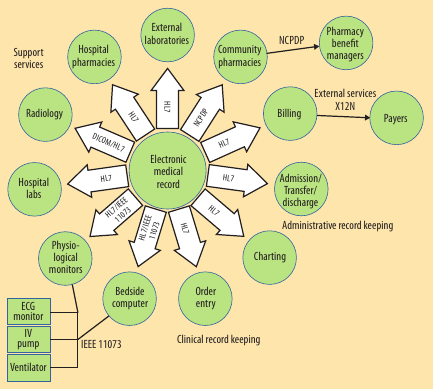Testing the Nation’s Healthcare Information Infrastructure: NIST Perspective
By Kevin Brady, Ram D. Sriram, Bettijoyce Lide, and Kathleen Roberts
NOTE: This is an overview of the entire article, which appeared in the November 2012 issue of the Computer magazine.
Click here to read the entire article.
(Editor’s Note) This article is from the November 2012 issue of Computer (ieeexplore.ieee.org) is a special issue on the subject of Electronic Health Records. All the articles in this very interesting special issue are available here.
A part of the effort in the US to rein in healthcare expenses, a major effort has been initiated to move to Electronic Health Records (EHRs), from the previous paper-based records. Various government agencies have been charged with supporting this effort. This article reports on work underway at the Information Technology Laboratory of the National Institute of Standards and Technology (NIST), to develop test methods, protocols and specifications for EHR interoperability.
Because of the sheer size of data involved, the critical need for patient security, and the complexity of diverse participating systems, the widespread adoption of EHRs poses significant technical challenges. Information generated in the healthcare enterprise must be digitally encoded with the right semantics, archived for efficient storage and retrieval, and transported reliably, securely, To take advantage of such automation, information generated in the healthcare enterprise must be digitally encoded with the right semantics, archived for efficient storage and retrieval, and transported reliably, securely, and efficiently, without any information loss. Accordingly, the National Institute of Standards and Technology has been working closely with ONC; Integrating the Healthcare Enterprise (IHE), an initiative by healthcare professionals and industry to improve the way healthcare computer systems share information; and other organizations, such as IEEE, to accelerate the adoption of information technology by US healthcare enterprises.
There are five classes of information used in healthcare:
- detailed medical records of each patient for every episode of illness or type of healthcare delivered;
- workflow for patient referrals to specialists, 3 physician orders for diagnostic tests or procedures, and hospital admission and discharge;
- detailed administrative records for managing healthcare resources – for example, scheduling patient appointments, tracking hospital bed utilization, and inventory management of pharmaceutical supplies;
- billing for healthcare services, healthcare cost control procedures, and coordination of benefits; and
- research reports, clinical observations, results of new pharmaceutical clinical trials, and new guidelines.
EHRs focus on the patient’s total health, going beyond standard clinical data collected in the provider’s office and include a broader view on a patient’s care. The widespread adoption of standards for information interchange of EHRs is critical if diverse healthcare systems are going to be able to share information efficiently and securely. Health Level Seven International (HL7) is the global authority on interoperability standards for health IT. By using IT that adheres to HL7 messaging standards, healthcare institutions could deal transparently with information obtained from external agencies as well as with information generated by in-house healthcare information systems. Figure 1 illustrates the classes of clinical information and some of the standards that link these classes to a full EHR. (Notably, in the US, 90 percent of hospitals use the HL7 standard.)

Figure 1. Standards that link to an electronic health record. (Source: US Congress, Office of Technology Assessment, Bringing Healthcare Online: The Role of Information Technologies, OTA-ITC-624, US Government Printing Office, Washington, D.C., 1995.)
This article describes how NIST is working with other standards organizations, consortia, and government agencies to build tools and prototypes to advance the adoption of IT within healthcare systems. Ongoing projects include, for instance:
- building an HL7 testing toolkit, which focuses on facilities to test HL7 message interfaces,
- creating testing tools to validate the HL7 Clinical Document Architecture (CDA). (CDA is an XML-based markup standard intended to specify the encoding, structure, and semantics of clinical documents for exchange), and
- working with industry to develop a standards- based registry infrastructure that will allow healthcare professionals to find and access all pertinent patient clinical information regardless of the healthcare organization that creates and manages the documents.
In conclusion, the authors point out what is needed to achieve full interoperability of health records, and the benefits of that interoperability. Also, they describe NIST’s planned participation in future testing in this area.
ABOUT THE AUTHORS
Kevin Brady is Interoperability Group leader, Systems and Software Division, Information Technology Laboratory, National Institute of Standards and Technology. His research interests include health information technology, smart healthcare, and cyberphysical systems. Brady received an MS in computer science from the George Washington University. Contact him at kevin.brady@nist.gov.
Ram D. Sriram is chief of the Systems and Software Division, Information Technology Laboratory, National Institute of Standards and Technology. His research interests include distributed design, artificial intelligence, and smart networked systems and societies. Sriram received a PhD in civil engineering from Carnegie Mellon University. He is a senior member of IEEE, a fellow of ASME and AAAS, and a life member of AAAI and ACM. Contact him at ram.sriram@nist.gov.
Bettijoyce Lide is the health IT program manager, Information Technology Laboratory, National Institute of Standards and Technology. Her research interests include health information technology, evaluated scientific data, and collaborations on cutting-edge R&D. Lide received an MS in chemistry, information technology, and management from the American University. She is a member of the American Chemical Society. Contact her at bjlide@nist.gov.
Kathleen Roberts is associate director for federal and industrial relations, Information Technology Laboratory, National Institute of Standards and Technology. Roberts received an MS in computer science from the George Washington University. Contact her at Kathleen.Roberts@nist.gov.






